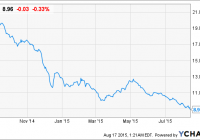Tactical Allocation: The Best Asset Categories Now
Summary Tactical allocation strategies use relative strength rankings to select asset categories. They often have a filter excluding those which are technically in a bear market. Here is the list of asset categories passing such a filter now. Tactical allocation strategies aim at selecting assets based on a relative strength ranking. They can easily be implemented with ETFs. The set of assets may be global (main asset classes), focused on a specific asset class, on a geographical classification in equities (regions, countries), or on sectors. The relative strength ranking is generally based on price action and technical indicators (momentum, risk-adjusted performance, volatility). Tactical quantitative models are most of the time designed to detect and follow the trends. They often have a better risk-adjusted performance when they include market-timing rules excluding the assets that are in a bear market. All is about the definition of what a “bear market” is. Practically, we use moving averages. A bearish signal is posted when the price falls below a long-term moving average (for example 200 days, 10 months, 1 year), or when a short-term moving average (for example 1 week, 1 month, 50 days) falls below a long-term moving average. For some models, the signal must be confirmed during a number of days to limit the risk of whipsaw. I run several models of this kind. Here is the list of ETFs that still pass a double filter: last closing price and the 50-day moving average must be both above the 200-day moving average (date: 9/15 on close ). This double filter, named hereafter “no-bear” filter, is an example that does not correspond exactly to what I am using in the models, and global timing rules may also exclude all long equity ETFs in the list at some times. Moreover, models keep only the top-ranked ETFs regarding the relative strength factor. Global Assets model Possible Holdings: Dollar Index (NYSEARCA: UUP ), 7-10 year US T-bonds (NYSEARCA: IEF ), 20+ year US T-bonds (NYSEARCA: TLT ), emerging market bonds ((NYSEARCA: PCY ), (NYSEARCA: EMB )), international sovereign bonds ex-U.S. (NYSEARCA: WIP ), the U.S. stock market (NYSEARCA: SPY ), developed countries stock markets ex-U.S. and Canada (NYSEARCA: EFA ), Latin America stock markets (NYSEARCA: ILF ), Pacific region stock markets ex-Japan (NYSEARCA: EPP ), U.S. real estate (NYSEARCA: ICF ), commodities (NYSEARCA: DBC ). Passing the “no-bear” filter: none Equities by Countries model Possible Holdings: U.S., Canada (NYSEARCA: EWC ), Russia (NYSEARCA: RSX ), Japan (NYSEARCA: EWJ ) China (NYSEARCA: FXI ), Europe (NYSEARCA: IEV ), Sweden (NYSEARCA: EWD ), Germany (NYSEARCA: EWG ), Hong-Kong (NYSEARCA: EWH ), South Africa (NYSEARCA: EZA ), Indonesia (NYSEARCA: IDX ), Thailand (NYSEARCA: THD ), South Korea (NYSEARCA: EWY ), Taiwan (NYSEARCA: EWT ), Malaysia (NYSEARCA: EWM ), Vietnam (NYSEARCA: VNM ), Brazil (NYSEARCA: EWZ ), Mexico (NYSEARCA: EWW ), Chile (NYSEARCA: ECH ), Colombia (NYSEARCA: GXG ), Peru (NYSEARCA: EPU ). Not all countries ETFs are included in the model for various reasons (liquidity, correlations). Passing the “no-bear” filter: none. U.S. Sectors and Industries Possible Holdings: Utilities (NYSEARCA: XLU ), Energy (NYSEARCA: XLE ), oil & gas exploration and production (NYSEARCA: XOP ), Financials (NYSEARCA: XLF ), healthcare (NYSEARCA: XLV ), Industrials (NYSEARCA: XLI ), technology (NYSEARCA: XLK ), Consumer staples (NYSEARCA: XLP ), home construction (NYSEARCA: ITB ), biotechnology (NASDAQ: IBB ), REITs , retail (NYSEARCA: RTH ), semi-conductors (NYSEARCA: SMH ), MLPs (NYSEARCA: AMLP ), internet (NYSEARCA: FDN ), solar energy (NYSEARCA: TAN ). Not all industry ETFs are included in the model because of liquidity filters, redundancy or other reasons. Passing the “no-bear” filter: FDN (internet), IBB (biotechnology), RTH (retail), ITB (home construction). Bond model Possible Holdings: core U.S. aggregate (NYSEARCA: AGG ), PIMCO total return (NYSEARCA: BOND ), Convertibles (NYSEARCA: CWB ), high yield (NYSEARCA: JNK ), 1-3 year T-bonds (NYSEARCA: SHY ), 3-7 year T-bonds (NYSEARCA: IEI ), 7-10 year T-bonds , 10-20 year T-bonds (NYSEARCA: TLH ), 1-5 years corporate bonds (NASDAQ: VCSH ). Passing the “no-bear” filter: ( SHY ), ( IEI ) (1-7 year T-bonds), ( VCSH ) (1-5 years corporate bonds). Conclusion The asset categories that still look good now from a tactical allocation point of view are short-term bonds (U.S. government and corporate, under 7 years of maturity) and equities in a few U.S. industries: internet, biotechnology, retail, home construction. Please note that these tactical allocation models are not a part of my subscription service , which is focused on a 20-stock defensive portfolio with hedging tactics based on a systemic risk indicator. Disclosure: I/we have no positions in any stocks mentioned, and no plans to initiate any positions within the next 72 hours. (More…) I wrote this article myself, and it expresses my own opinions. I am not receiving compensation for it. I have no business relationship with any company whose stock is mentioned in this article. Additional disclosure: I short the S&P 500 for hedging purposes.
